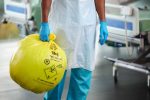The re-emergence of Mpox has opened dialogue surrounding the management of infectious waste. There is currently little information on the transmission of Mpox within healthcare settings, so to minimise the risk of contact, enforcing proper waste management protocol is imperative.
As outlined in the Multilateral Agreement M347 under section 1.5.1 of ADR, a temporary derogation of Paragraph 2.2.62.1.4.1, Section 3.2.1. (Table A, Dangerous Goods List) and Chapter 4.1 of ADR, infectious substances contaminated with Mpox, excluding Mpox cultures, can be transported under UN 3373 or UN 3291 as appropriate.
What is UN 3373 and UN 3291?
The ADR is a UN agreement regarding the safe carriage of dangerous goods. Infectious materials, including those contaminated with viruses or disease fall under the classification of dangerous goods, meaning transportation of these materials must be in compliance with UN regulations. UN numbers are used to classify infectious waste as dangerous goods for transport. UN 3373 classification refers to Category B biological substances, primarily small cultures and diagnostic specimens, whilst UN 3291 classification refers to Category B substances that are inclusive of clinical waste and regulated medical waste.
What does this mean for the disposal of Mpox contaminated waste?
Under this derogation, infectious waste contaminated with Mpox can be disposed of in infectious clinical waste streams (orange and yellow bags), providing the transport of waste is accompanied by the following information within its consignment note “Carriage in accordance with Multilateral Agreement M347”.




















